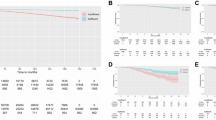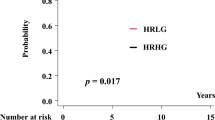Abstract
Purpose: Fewer patients newly diagnosed with prostate cancer today have biopsy Gleason sums <6 compared to several years ago. Several tables and nomograms for predicting disease recurrence after definitive therapy provide little or no discrimination between biopsy Gleason sums 4, 5, and 6. We sought to examine the significance of biopsy Gleason sum for predicting biochemical failure following radical prostatectomy (RP) for men with biopsy Gleason sums of 4, 5, and 6.
Materials and methods: We examined data from 988 men treated with RP between 1988 and 2002 who had biopsy Gleason sums of 4–6. Clinical and pathological variables as well as outcome information were compared between men with biopsy Gleason sums of 4–6. The log-rank and Cox proportional hazards analysis were used to determine whether biopsy Gleason sum provided unique prognostic information for men with low biopsy Gleason sums undergoing RP.
Results: There was statistically significant, but overall weak correlation between biopsy Gleason sum and Gleason sum of the RP specimen (Spearman's r=0.277, P<0.001). As biopsy Gleason sum increased from 4 to 5 to 6, there was a steady rise (HR=1.31 for each one point increase in Gleason sum, Cox's model) in the risk of PSA failure (P=0.025, log-rank). On multivariate analysis comparing biopsy Gleason sum, preoperative PSA, clinical stage, year of surgery, percent of biopsy cores positive, and age for their ability to predict time to biochemical recurrence, only PSA (HR 2.09, CI 1.56–2.80, P<0.001) and biopsy Gleason sum (HR 1.33, CI 1.05–1.70, P=0.019) were significant independent predictors of PSA failure.
Conclusions: Despite weak correlation between biopsy and pathologic Gleason sum among men with biopsy Gleason sum 4–6 tumors, grade was a significant independent predictor of PSA failure following RP. In the range of 4–6, biopsy Gleason sum acted as a continuous variable for predicting PSA failure. The routine use of Gleason sums 4 and 5 to grade prostate needle biopsy specimens should not be abandoned.
This is a preview of subscription content, access via your institution
Access options
Subscribe to this journal
Receive 4 print issues and online access
$259.00 per year
only $64.75 per issue
Buy this article
- Purchase on Springer Link
- Instant access to full article PDF
Prices may be subject to local taxes which are calculated during checkout

Similar content being viewed by others
References
D'Amico AV et al. Biochemical outcome after radical prostatectomy, external beam radiation therapy, or interstitial radiation therapy for clinically localized prostate cancer. JAMA 1998; 280: 969–974.
Kattan MW et al. A preoperative nomogram for disease recurrence following radical prostatectomy for prostate cancer. J Natl Cancer Inst 1998; 90: 766–771.
Gleason DF . Classification of prostatic carcinomas. Cancer Chemother Rep 1966; 50: 125–128.
Soh S et al. Has there been a recent shift in the pathological features and prognosis of patients treated with radical prostatectomy? J Urol 1997; 157: 2212–2218.
Schwartz KL, Grignon DJ, Sakr WA, Wood Jr DP . Prostate cancer histologic trends in the metropolitan Detroit area, 1982 to 1996. Urology 1999; 53: 769–774.
Han M et al. Era specific biochemical recurrence-free survival following radical prostatectomy for clinically localized prostate cancer. J Urol 2001; 166: 416–419.
Freedland SJ et al. Time trends in biochemical recurrence after radical prostatectomy: results of the SEARCH database. Urology 2003; 61: 736–741.
Smith EB et al. Gleason scores of prostate biopsy and radical prostatectomy specimens over the past 10 years: is there evidence for systematic upgrading? Cancer 2002; 94: 2282–2287.
Epstein JI . Gleason score 2-4 adenocarcinoma of the prostate on needle biopsy: a diagnosis that should not be made. Am J Surg Pathol 2000; 24: 477–478.
Nelson CP et al. Preoperative parameters for predicting early prostate cancer recurrence after radical prostatectomy. Urology 2002; 59: 740–745 discussion 745–746.
Partin AW et al. Contemporary update of prostate cancer staging nomograms (Partin Tables) for the new millennium. Urology 2001; 58: 843–848.
Albertsen PC, Hanley JA, Gleason DF, Barry MJ . Competing risk analysis of men aged 55 to 74 years at diagnosis managed conservatively for clinically localized prostate cancer. JAMA 1998; 280: 975–980.
Freedland SJ et al. Race as an outcome predictor after radical prostatectomy: results from the Shared Equal Access Regional Cancer Hospital (SEARCH) database. Urology 2002; 60: 670–674.
Terris MK . Sensitivity and specificity of sextant biopsies in the detection of prostate cancer: preliminary report. Urology 1999; 54: 486–489.
Borirakchanyavat S et al. Systematic sextant biopsies in the prediction of extracapsular extension at radical prostatectomy. Urology 1997; 50: 373–378.
Freedland SJ et al. Race is not an independent predictor of biochemical recurrence after radical prostatectomy in an equal access medical center. Urology 2000; 56: 87–91.
Borboroglu PG, Comer SW, Riffenburgh RH, Amling CL . Extensive repeat transrectal ultrasound guided prostate biopsy in patients with previous benign sextant biopsies. J Urol 2000; 163: 158–162.
Zagars GK, Ayala AG, von Eschenbach AC, Pollack A . The prognostic importance of Gleason grade in prostatic adenocarcinoma: a long-term follow-up study of 648 patients treated with radiation therapy. Int J Radiat Oncol Biol Phys 1995; 31: 237–245.
McNeal JE et al. Histologic differentiation, cancer volume, and pelvic lymph node metastasis in adenocarcinoma of the prostate. Cancer 1990; 66: 1225–1233.
Steinberg DM, Sauvageot J, Piantadosi S, Epstein JI . Correlation of prostate needle biopsy and radical prostatectomy Gleason grade in academic and community settings. Am J Surg Pathol 1997; 21: 566–576.
Allsbrook Jr WC et al. Interobserver reproducibility of Gleason grading of prostatic carcinoma: urologic pathologists. Hum Pathol 2001; 32: 74–80.
Bostwick DG . Grading prostate cancer. Am J Clin Pathol 1994; 102: S38–56.
Gardner Jr WA et al. A uniform histopathologic grading system for prostate cancer. Subcommittee on Diagnostic Nomenclature, Prostate Cancer Working Group, Organ Systems Program. Hum Pathol 1988; 19: 119–120.
Acknowledgements
This work was supported by the Department of Veterans Affairs and a Center for Prostate Disease Research (CPDR) grant from the United States Army Medical Research and Material Command.
Author information
Authors and Affiliations
Consortia
Corresponding author
Rights and permissions
About this article
Cite this article
The SEARCH Database Study Group;., Freedland, S., Amling, C. et al. Is there a difference in outcome after radical prostatectomy between patients with biopsy Gleason sums 4, 5, and 6? results from the SEARCH database. Prostate Cancer Prostatic Dis 6, 261–265 (2003). https://doi.org/10.1038/sj.pcan.4500673
Received:
Revised:
Accepted:
Published:
Issue Date:
DOI: https://doi.org/10.1038/sj.pcan.4500673



